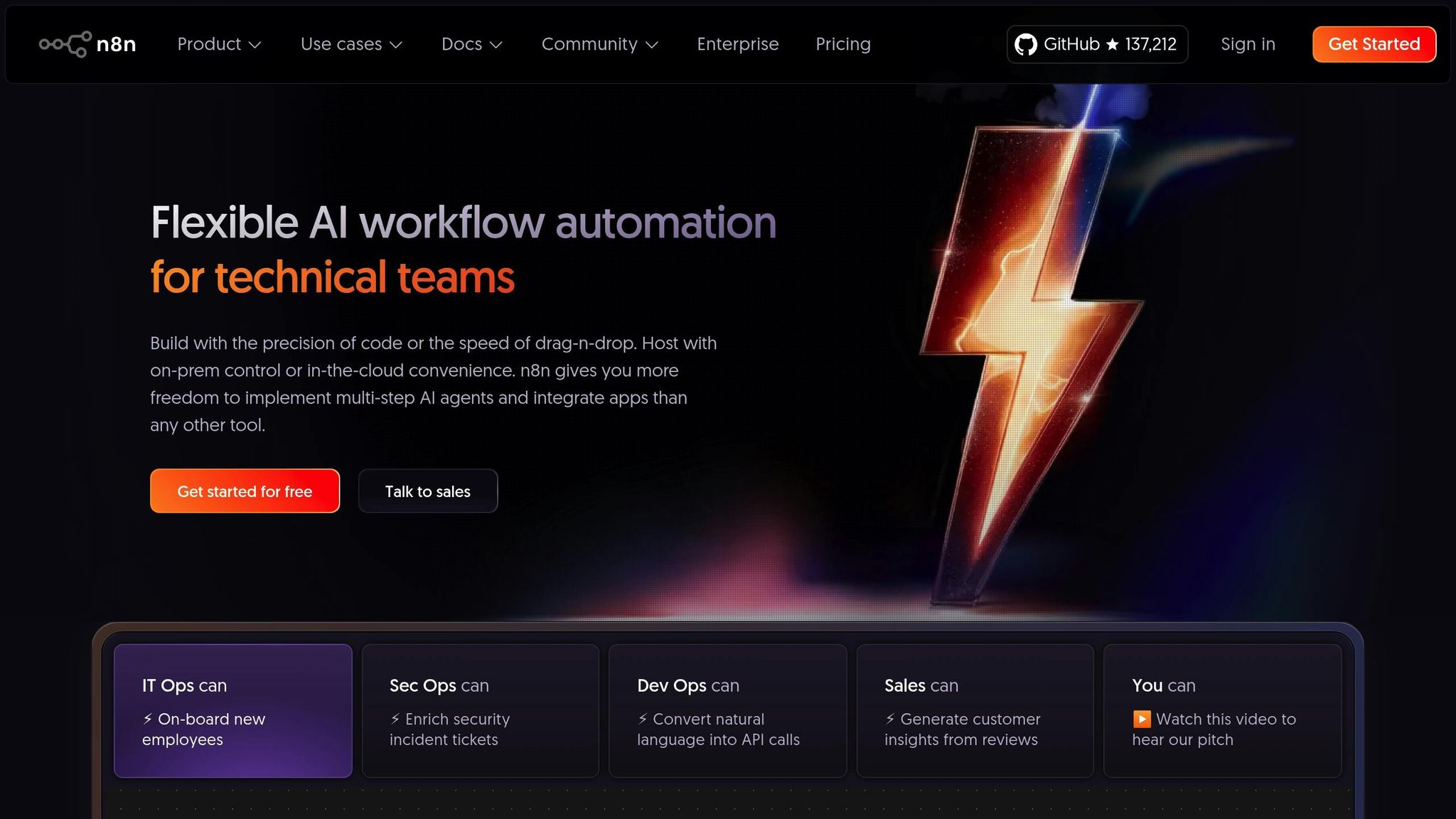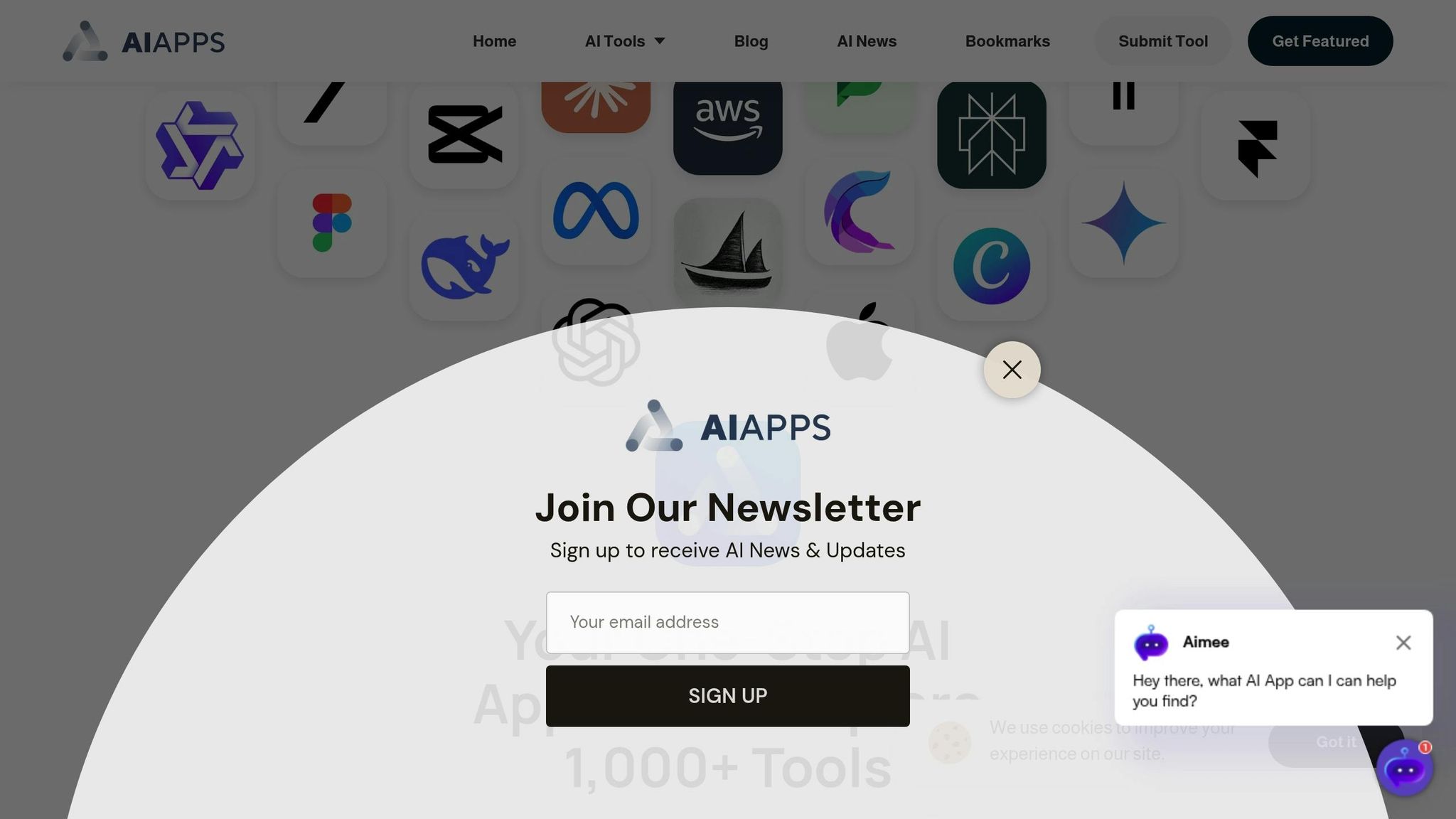AI workflow integration is about embedding artificial intelligence directly into your business processes to improve efficiency and decision-making. Instead of using AI as a standalone tool, it becomes a natural part of how tasks progress, automating repetitive work, analyzing data, and providing actionable insights. This approach saves time, reduces errors, and allows employees to focus on higher-value tasks, like problem-solving and strategy.
Key takeaways:
- Audit workflows: Identify inefficiencies and areas where AI can improve processes.
- Choose the right tools: Prioritize functionality, ease of use, and compatibility with your systems.
- Manage change effectively: Train teams, involve employees early, and set up feedback loops for continuous improvement.
AI integration isn’t just about automation - it’s about transforming how work gets done while keeping human expertise at the center. By redesigning workflows and aligning AI with business goals, companies can achieve faster operations, better insights, and scalable growth.
3 AI Workflows Step-by-Step (Beginner's Guide to n8n)

Assessing and Mapping Current Workflows
Take a close look at your current workflows to uncover inefficiencies and pinpoint areas where AI can make a meaningful difference.
This involves analyzing how tasks flow between team members, identifying delays, and determining which activities consume too much time relative to their value. The goal is to figure out if AI will truly transform your workflows or just automate existing inefficiencies.
This process also emphasizes the human factors that make workflows successful. By understanding these nuances, you can ensure AI complements rather than disrupts the collaborative dynamics that are vital to your business. Mapping workflows clearly lays the groundwork for choosing AI tools that fit seamlessly into an improved system.
Conducting a Workflow Audit
A proper workflow audit starts with observing how work actually gets done. Often, the documented process doesn’t match the reality of day-to-day operations. Employees may rely on informal workarounds, shortcuts, or unrecorded handoffs to keep things moving.
Spend time shadowing employees to track how long tasks take, where approvals cause delays, and how often they switch between tools. Pay attention to pain points like duplicate data entry or bottlenecks. These observations help you spot inefficiencies and areas where AI could step in, such as automating repetitive tasks or providing smarter recommendations.
Also, look for patterns in decision-making that slow things down. For example, if employees frequently pause to categorize requests or review customer histories, AI-powered tools could automate or speed up these steps. Analyze activity volumes and timing - such as peak periods or seasonal trends - to identify where AI could ease the burden during busy times.
Use the findings from your audit to create detailed maps of your workflows.
Process Mapping and Documentation
Visual workflow maps can help you see the full picture - official procedures alongside the real-world operations. Include handoffs, delays, and decision points to uncover opportunities for improvement. Break down each stage in detail, noting every handoff, approval, and system interaction. Highlight where human tasks meet system processes and identify decision points where AI might step in.
Add timing information to your maps. Show how long tasks take and where work sits idle. This helps you quantify the potential impact of AI. For example, if certain steps face frequent delays, automating them could significantly cut wait times and boost efficiency.
Document the data and knowledge employees rely on at each step. What systems do they consult? What information do they need to make decisions? This level of detail ensures you choose AI tools that integrate seamlessly with your existing data sources and processes.
Don’t forget to include how exceptions are handled. What happens when the standard process breaks down? Understanding these edge cases ensures your AI solutions remain flexible enough to handle unusual situations. Make sure your maps also capture human interactions, preserving the collaborative aspects of your workflows.
Aligning AI Integration with Business Goals
When introducing AI, tie it to clear business objectives, such as cutting processing times or improving customer response rates. Knowing your baseline metrics allows you to set realistic goals and measure the impact of AI on your operations.
Think about both short-term improvements and long-term benefits. While AI may initially streamline repetitive tasks, the real value often lies in freeing up your team for higher-level work, like building relationships, solving complex problems, or planning strategically.
Consider how workflow improvements can strengthen your competitive position. For example, if faster customer service sets you apart, reducing response times with AI could give you an edge. Similarly, if accuracy and compliance are critical, focus on AI tools that reduce errors and maintain audit trails.
Set specific, measurable goals for your AI initiatives. Instead of vague targets like "boost efficiency", aim for something concrete, like "reduce invoice processing time by 60% within six months" or "increase first-call resolution rates from 75% to 90% within a year." These benchmarks guide your tool selection and provide clear criteria for success.
As with workflow assessments, aligning AI integration with your business goals ensures your efforts are focused and effective. Keep in mind that success often requires balancing priorities. While speed and efficiency are important, you must also maintain quality, meet compliance standards, and preserve the human touch that drives customer satisfaction and employee engagement.
Selecting and Integrating AI Tools
Once you've audited your workflows, the next step is to carefully select and integrate AI tools that align with your business objectives. With a clear understanding of your processes, you can focus on tools that bring value and integrate smoothly into your operations.
The key is matching the strengths of each tool to your specific workflow needs while ensuring scalability and minimal maintenance. A thoughtful approach here can mean the difference between success and costly setbacks.
Criteria for Choosing AI Tools
Start by evaluating the functionality of potential tools. Check their accuracy and ensure their data sources align with your workflow requirements. Tools that regularly update their training data and release new versions are more likely to stay relevant over time.
User experience is another critical factor. Look for tools that are accessible, with features like screen reader support and compliance with accessibility standards. An intuitive interface that requires minimal training is essential for smooth adoption. Strong customer support, including access to technical teams and training resources, can also make a big difference.
Ethical and legal considerations should not be overlooked. Choose tools designed to reduce bias and avoid stereotypical outputs. Verify their copyright compliance by ensuring transparent training data and proper source citation. Additionally, review their privacy policies and data protection measures. Tools that emphasize fairness, transparency, and accountability can help you avoid potential ethical pitfalls.
Finally, consider cost and integration. Beyond subscription fees, think about the total cost, including training, maintenance, and potential customization. Check for integration capabilities, such as compatibility with your existing software and available APIs. Also, ensure the tool offers reproducibility, so you can consistently achieve the same results under similar conditions.
When narrowing down your options, pay close attention to three key areas: integration capabilities, user experience, and security features. These factors often determine the success or failure of AI implementation.
Using Platforms Like AI Apps

With so many AI tools available, finding the right one can feel overwhelming. Platforms like AI Apps simplify this process by offering a centralized hub of over 1,000 curated AI tools. These tools cover areas like automation, text creation, data analysis, and image or video editing.
The platform's advanced filtering options let you refine your search by category, sub-category, or pricing model, making it easier to find tools tailored to your workflow needs. You can even compare tools side-by-side to identify the best fit.
AI Apps also uses a multi-step verification process to ensure the quality of the tools it lists, reducing the risk of selecting unreliable or poorly maintained options. The platform highlights both featured tools and new releases, giving you access to emerging solutions that could provide a competitive edge.
Beyond tool discovery, AI Apps offers valuable insights through its blog, covering AI trends and best practices. This combination of discovery and education makes it easier to make well-informed decisions about which tools will best integrate into your workflows.
Integration Methods: Comparing Options
Once you've chosen a tool, the next step is determining how to integrate it into your systems. Different integration methods come with varying levels of customization, speed, and maintenance needs. Choosing the right method depends on your technical resources and the complexity of your workflows.
| Integration Method | Speed to Deploy | Customization Level | Maintenance Requirements | Best For |
|---|---|---|---|---|
| API-based Integration | Fast | Medium | Low to Medium | Businesses with existing tech infrastructure |
| Pre-built Connectors | Very Fast | Low | Very Low | Quick implementations with popular tools |
| Custom-built Solutions | Slow | Very High | High | Complex workflows needing specific features |
| No-code Platforms | Fast | Medium | Low | Teams without extensive technical resources |
API-based integration is often the best choice for businesses. It offers a good balance of customization and low maintenance, making it ideal for connecting AI tools to existing databases or applications without heavy development.
Pre-built connectors are perfect for rapid deployment, especially when integrating popular tools with common software like CRM or project management platforms. However, they offer limited customization options.
Custom-built solutions provide full control but require significant technical expertise and ongoing maintenance. This approach is best for highly specialized workflows where off-the-shelf solutions fall short.
No-code platforms are a great starting point for teams with limited technical resources. They allow users to create integrations without programming knowledge, making them ideal for straightforward automation tasks.
Choose your integration method based on your team's technical skills, project timeline, and the complexity of your workflows. You can always start with simpler methods and transition to more advanced approaches as your AI capabilities grow.
sbb-itb-212c9ea
Change Management and Team Training
For AI integration to truly work, teams must adapt and engage with the tools. Even the most advanced AI systems can fall flat without proper team involvement, leading to resistance, wasted resources, and underwhelming results. A people-focused strategy, built on earlier workflow assessments, ensures that AI tools become a natural part of daily operations rather than an awkward addition.
The success or failure of AI adoption often hinges on the human factor. When teams feel left out or unprepared for their shifting roles, resistance builds, and adoption rates plummet. This is why involving your team from the start is critical.
Getting Teams Involved in the Integration Process
Involving employees early on is key to fostering support across the organization. Start by identifying champions from different departments who can represent diverse perspectives and help drive the initiative forward.
Form cross-functional teams that include both tech-savvy employees and those who work directly with the processes AI will impact. This blend ensures that the technical and practical sides of the integration work together seamlessly. Hosting regular town hall meetings gives employees a platform to share concerns, ask questions, and contribute ideas before any major decisions are finalized.
Providing clarity is another essential step. Share detailed timelines and explain how AI will impact workflows, evolve job roles, and create new opportunities. Address fears about job security head-on by emphasizing how AI tools are designed to enhance human capabilities rather than replace them.
Consider starting with a pilot program in select teams. This allows you to test the integration, gather valuable feedback, and create success stories that can inspire others. Employees who participate in these pilots often become your strongest advocates, helping to dispel doubts among their peers.
Frequent communication is just as important as the content itself. Regular updates, even if there’s little progress to report, keep the initiative visible and demonstrate leadership’s commitment. Use a mix of communication channels - emails, team meetings, and internal newsletters - to ensure you’re reaching everyone effectively.
Training and Upskilling for AI Tools
Tailor training programs to fit specific roles, building on the workflows you’ve already mapped out. Start by assessing current skills to create targeted, hands-on learning paths that align with each team’s needs.
Practical, hands-on training works best for AI adoption. Create sandbox environments where employees can practice using AI tools with non-critical data. This lets them experiment, make mistakes, and learn without risking real-world consequences.
Encourage peer-to-peer learning by pairing experienced users with newcomers. These mentorships not only build expertise but also strengthen collaboration and knowledge sharing within teams.
For busy professionals, microlearning sessions are more effective than long workshops. Break training into 15-20 minute modules that employees can tackle during short breaks. This makes the process less overwhelming and improves retention.
Introduce certification programs to set clear learning goals and recognize employees who invest in developing AI skills. These programs can be motivating and help identify potential internal trainers or team leaders.
Setting Up Feedback Loops for Continuous Improvement
Feedback is the backbone of a successful AI rollout. Schedule regular check-ins with users to address challenges early on. During the first month, hold weekly or bi-weekly sessions, then shift to monthly reviews as teams grow more comfortable. Focus these discussions on solving practical issues rather than collecting general satisfaction data.
Use analytics - such as login frequency, feature usage, and task completion rates - along with varied feedback methods like surveys, forms, and one-on-one discussions to identify and address problems quickly.
Responding to feedback promptly is crucial. Acknowledge all suggestions within 48 hours, even if you can’t act on them right away. When certain ideas can’t be implemented, explain why and offer alternative solutions to maintain trust.
Organize feedback into categories like technical issues, training gaps, workflow conflicts, and feature requests. This makes it easier to identify patterns and allocate resources to the most pressing concerns.
Share success stories to highlight how AI tools are making a positive impact. Whether it’s improved efficiency, fewer errors, or better outcomes, these examples can inspire other teams to embrace the changes.
Finally, show employees that their input leads to real change. Regularly communicate updates made in response to feedback, and document how these adjustments improve workflows. This transparency builds trust and encourages ongoing participation, ensuring that the AI tools continue to evolve alongside your team’s needs.
Redesigning Workflows for Long-term AI Integration
To fully harness AI's potential, workflows need a fresh perspective. This means rethinking processes to ensure they deliver improvements that grow alongside your organization.
Optimizing Workflows with AI
Start by pinpointing repetitive tasks where AI can take over, freeing up your team to focus on higher-value work. These are often time-consuming activities that don’t require creativity or complex decision-making.
Consider hybrid workflows where AI handles routine tasks while humans step in for exceptions and final approvals. For example, AI can pre-screen job applications based on set criteria, but hiring managers still conduct interviews and make the final call. This setup keeps human oversight intact while cutting down on manual effort.
Integrate AI insights directly into your team's tools. For instance, if AI identifies trends in customer behavior, those insights should appear automatically in your marketing dashboards, streamlining decision-making.
Shift resources from routine work to strategic initiatives. For example, customer service teams can focus on resolving complex issues and building stronger client relationships, while AI handles basic queries through chatbots and automated systems.
Set up clear escalation paths for more challenging cases. Define triggers - like customer sentiment scores or specific keywords - that automatically route issues to the right team members. This ensures no issue is overlooked while maintaining efficiency.
Leverage parallel processing to save time. While AI analyzes data and prepares reports, your team can work on strategy and communication, reducing project timelines and improving outcomes.
Once workflows are redesigned, measure the tangible benefits to ensure the changes are delivering results.
Monitoring and Measuring AI Performance
After optimizing workflows, it’s critical to monitor AI's performance to ensure ongoing success. Start by setting baseline metrics and tracking key indicators like processing time, error rates, and customer satisfaction. These provide a clear picture of AI's impact on your operations.
Focus on outcome-based metrics rather than activity alone. For example, instead of just counting how many emails AI processes, assess whether response times have improved or customer satisfaction has increased. This gives you a better understanding of AI's value.
Use real-time monitoring dashboards to track AI performance and workflow efficiency. Keep an eye on metrics like task completion rates, accuracy, system uptime, and user adoption. Set up automated alerts to notify your team if performance drops below acceptable levels.
A/B testing can help compare AI-enhanced workflows with traditional ones. Run both processes in parallel for a set period to gather data on improvements in speed, accuracy, and cost-effectiveness. This evidence helps justify investments and highlights areas for further refinement.
Don’t overlook user satisfaction metrics. Regularly survey employees to gauge their experience with AI workflows, focusing on ease of use, time savings, and overall job satisfaction. The goal is for AI to make work easier, not more frustrating.
Implement cost-benefit tracking that goes beyond simple ROI. Monitor factors like reduced overtime, faster project completion, improved employee retention, and better customer satisfaction. These broader metrics offer a more complete view of AI's impact.
Regular Workflow Review
Schedule quarterly reviews to fine-tune AI integration and ensure it remains scalable. These sessions should include both technical teams and end users to capture a full picture of how AI affects daily operations.
Adopt a continuous improvement mindset. Document successes, identify bottlenecks, and prioritize updates based on their potential impact and ease of implementation.
Stay informed about advances in AI technology that could enhance your workflows. New features or improved tools can deliver better results. Dedicate time each quarter to evaluate updates and explore tools like AI Apps, which regularly adds new capabilities to its extensive library.
Regularly reassess how your AI-enhanced workflows align with business goals. As priorities shift or market conditions evolve, workflows may need adjustments to stay effective.
Conduct scalability reviews to ensure your AI systems can handle increased workloads or expanded use cases. Address potential bottlenecks early and plan for upgrades or changes to keep operations running smoothly.
Use feedback loops to guide improvements. Establish protocols for collecting and implementing user suggestions, ensuring that insights from daily users drive meaningful updates.
Finally, plan technology refresh cycles to keep up with AI advancements. Set realistic timelines for evaluating new tools, migrating data, and retraining teams to maintain the effectiveness of your AI integration over the long term. Keep your systems current to ensure they continue delivering value as your needs evolve.
Conclusion
Successfully integrating AI into your business boils down to three key steps: evaluating workflows, choosing the right tools, and managing change effectively. Start by thoroughly assessing your workflows and documenting processes to design AI-powered systems that deliver meaningful outcomes.
When it comes to tools, pick solutions that align with your business needs and work seamlessly with your existing systems. Platforms like AI Apps make this easier by offering access to over 1,000 curated AI tools across various categories. They allow you to compare options and find tools that match your workflow requirements and budget, ensuring a smooth technical fit. But tools are just one part of the equation.
The human side of integration is just as important. Provide strong change management and team training to ensure a smooth transition. When employees see how AI enhances their work rather than replacing it, they’re more likely to embrace the technology. Create feedback loops so that user insights from daily operations can drive ongoing improvements.
Long-term success also depends on continuous refinement. Regularly monitor performance, conduct quarterly reviews, and stay updated on technological advancements to keep your AI systems effective and scalable. The aim is to build workflows that evolve alongside your organization and adapt to shifting business needs.
AI isn’t about replacing people or automating everything - it’s about strategically improving processes where technology adds value. Focus on areas like repetitive tasks, data analysis, and routine decisions, while leaving complex problem-solving and creative work in human hands.
With thoughtful planning and ongoing optimization, AI can become a powerful tool that boosts productivity, enhances accuracy, and lets your team focus on the work that truly matters.
FAQs
What are the best ways to integrate AI tools into existing workflows without causing disruptions?
To bring AI tools into your current workflows without a hitch, it's all about thoughtful planning and putting people at the center of the process. Begin by pinpointing where AI can genuinely make a difference, then outline how it can fit seamlessly into your existing operations.
Communication plays a huge role here. Keep your team in the loop about upcoming changes, and offer training to ensure everyone feels confident using the new tools. You might also consider designating "AI champions" within your team - these individuals can encourage adoption, answer questions, and address any concerns that come up. Taking these steps can help reduce disruptions and make the most of what AI can bring to your workflows.
What should I consider when choosing AI tools for workflow integration?
When choosing AI tools to integrate into your workflow, it's crucial to consider their compatibility with your existing systems. This ensures everything runs smoothly and prevents the creation of isolated processes. Opt for tools capable of managing complex tasks, such as multi-step processes, automation, and conditional logic, to simplify and enhance your workflows.
Equally important are factors like ease of use and scalability, so the tools can adapt as your needs grow. Make sure they include strong data security measures to safeguard sensitive information. Lastly, prioritize solutions that offer dependable customer support and clear, comprehensive documentation to make onboarding easier and ensure a seamless implementation.
What are the best ways to manage change and keep teams engaged when integrating AI into workflows?
Managing change while keeping teams engaged during AI integration starts with open communication and involving employees from the beginning. Share the purpose behind adopting AI, highlight its benefits, and explain how it might impact day-to-day operations. This transparency helps build trust and ensures everyone feels informed.
To gain support, consider appointing key team members as AI advocates. These individuals can help explain the changes, address concerns, and act as a bridge between leadership and the rest of the team. Offering role-specific training is another critical step. When employees understand how AI tools fit into their responsibilities, they’re more likely to feel confident and ready to adapt.
Encouraging collaboration and creating spaces for feedback is equally important. When employees feel heard, resistance decreases, and they’re more likely to embrace new technologies. By prioritizing communication, training, and teamwork, companies can make the transition to AI smoother and more effective.



